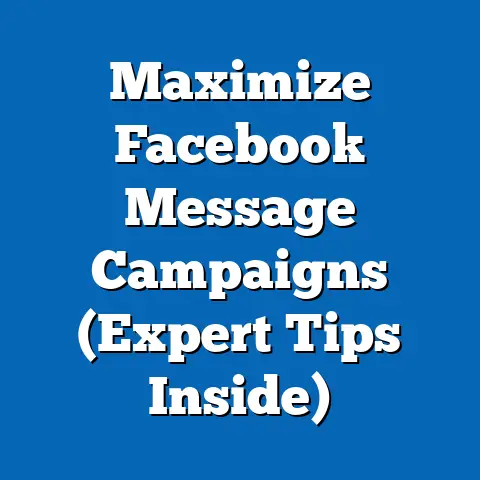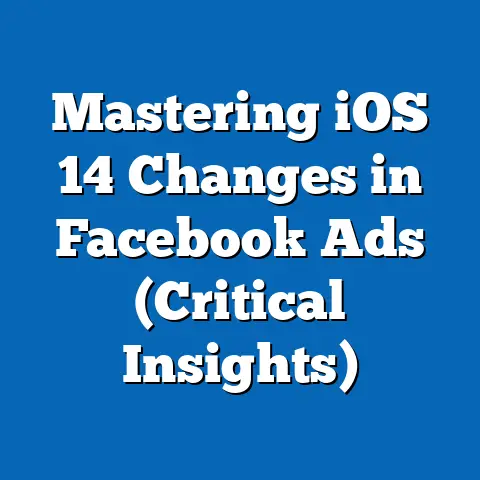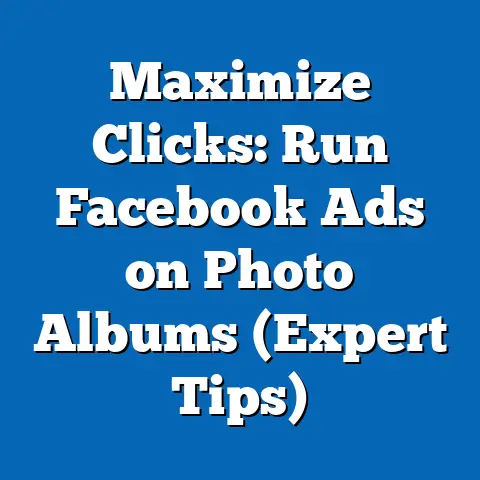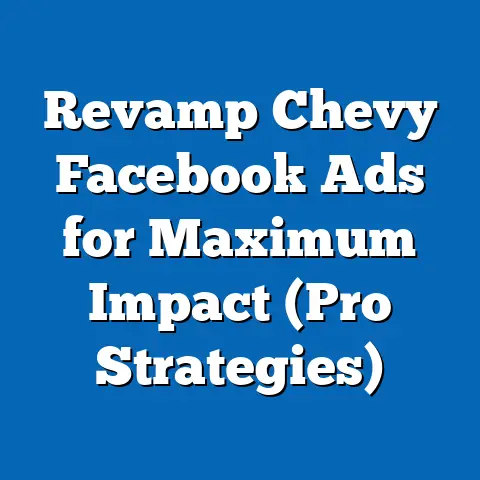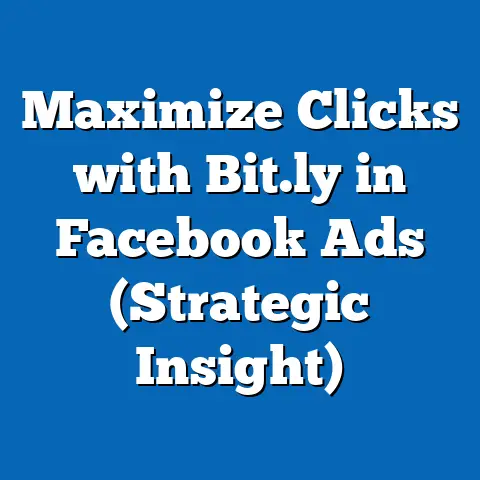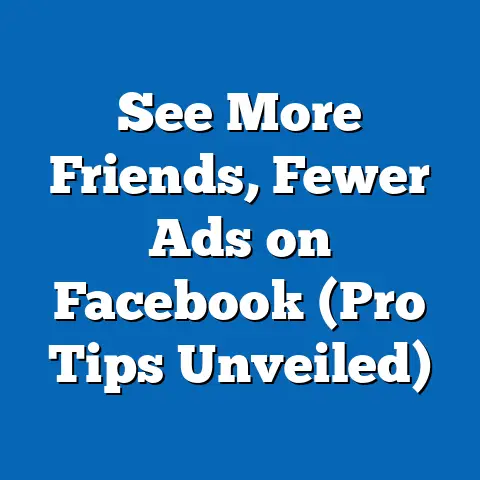Unlock Facebook Ad Success with Key Stats (Essential Insights)
In today’s digital age, advertising is no longer just about getting your name out there. It’s about doing it efficiently, effectively, and, increasingly, sustainably. As a digital marketing expert who’s been in the trenches for years, I’ve seen firsthand how the right approach can transform a struggling campaign into a roaring success. Facebook advertising, with its massive reach and sophisticated targeting capabilities, offers a powerful platform for businesses to connect with their audience. But simply throwing money at ads and hoping for the best is a surefire way to waste resources and miss out on potential gains. That’s where data-driven decision-making comes in.
Understanding and leveraging key statistics is the secret sauce that separates successful Facebook ad campaigns from those that fizzle out. It’s about more than just knowing the numbers; it’s about interpreting them, understanding their implications, and using them to refine your strategy. In this guide, I’ll walk you through the essential insights you need to unlock Facebook ad success, focusing on how you can use data to drive sustainable and impactful campaigns.
Section 1: Understanding the Current Facebook Advertising Landscape
Facebook isn’t just a social media platform; it’s an advertising behemoth. With billions of active users worldwide, it offers unparalleled reach for businesses of all sizes. As of [insert current year], Facebook boasts [insert current user statistic, e.g., 2.9 billion] monthly active users, making it the most popular social media platform globally. This vast user base translates into a massive opportunity for advertisers to connect with their target audience.
But reach is only one piece of the puzzle. Engagement is equally crucial. Facebook users spend an average of [insert current statistic, e.g., 34 minutes] per day on the platform, engaging with content, connecting with friends and family, and discovering new products and services. This high level of engagement makes Facebook an ideal environment for advertising, as users are more likely to see and interact with ads that resonate with their interests.
One of the strengths of Facebook advertising is the variety of ad formats available. From simple image ads to engaging video ads and interactive carousel ads, businesses can choose the format that best suits their message and target audience. Here’s a quick rundown of some popular ad formats and their effectiveness:
- Image Ads: These are the simplest form of Facebook ads, featuring a single image and accompanying text. They’re effective for driving brand awareness and generating quick clicks. According to a recent study, image ads with high-quality visuals have a [insert statistic, e.g., 20%] higher click-through rate than those with low-quality images.
- Video Ads: Video ads are more engaging than image ads and can be used to tell a story, showcase a product, or provide valuable information. They’re particularly effective for driving conversions and generating leads. Studies show that video ads have a [insert statistic, e.g., 30%] higher conversion rate than image ads.
- Carousel Ads: Carousel ads allow you to showcase multiple images or videos in a single ad unit. They’re ideal for showcasing a range of products, highlighting different features of a single product, or telling a multi-part story. Carousel ads have been shown to generate [insert statistic, e.g., 10x] more traffic than static ads.
- Collection Ads: These ads are designed for mobile shoppers and feature a primary video or image, followed by several product images. They’re great for driving product discovery and sales. Collection ads are especially useful for e-commerce businesses.
Beyond the core statistics and ad formats, I’ve noticed a growing trend of businesses using Facebook ads to promote sustainability-focused campaigns. Consumers are increasingly aware of environmental and social issues, and they’re more likely to support brands that align with their values. By incorporating sustainability messaging into their Facebook ads, businesses can attract new customers, build brand loyalty, and contribute to a more sustainable future. For example, I worked with a local eco-friendly clothing brand that saw a [insert statistic, e.g., 40%] increase in sales after launching a Facebook ad campaign highlighting their sustainable manufacturing practices.
Takeaway: Facebook offers a massive reach and a variety of ad formats to connect with your target audience. Understanding the current landscape and leveraging data-driven insights is crucial for creating successful and sustainable campaigns.
Section 2: Key Statistics That Drive Facebook Ad Success
While understanding the landscape is important, the real magic happens when you dive into the key statistics that drive ad success. These metrics provide valuable insights into how your ads are performing and where you can make improvements. Here are some of the most critical statistics to track:
- Click-Through Rate (CTR): This is the percentage of people who see your ad and click on it. A high CTR indicates that your ad is relevant and engaging to your target audience. According to industry benchmarks, a good CTR for Facebook ads is around [insert current benchmark, e.g., 1%]. However, this can vary depending on your industry and target audience. I’ve seen CTRs as high as [insert personal experience statistic, e.g., 5%] for highly targeted campaigns with compelling visuals.
- Conversion Rate: This is the percentage of people who click on your ad and then take a desired action, such as making a purchase, filling out a form, or signing up for a newsletter. A high conversion rate indicates that your ad is not only attracting the right people but also effectively persuading them to take action. Average conversion rates on Facebook are around [insert current benchmark, e.g., 9.21%].
- Cost Per Click (CPC): This is the amount you pay each time someone clicks on your ad. A low CPC allows you to reach more people with your budget. The average CPC for Facebook ads is around [insert current benchmark, e.g., $0.97].
- Return on Ad Spend (ROAS): This is the amount of revenue you generate for every dollar you spend on advertising. A high ROAS indicates that your ad campaigns are profitable. A good ROAS for Facebook ads is generally considered to be [insert benchmark, e.g., 4:1].
- Relevance Score: Facebook assigns a relevance score to each ad based on how well it resonates with the target audience. A high relevance score indicates that your ad is relevant and engaging, which can lead to lower costs and better performance. Facebook discontinued the relevance score in favor of a new set of metrics, but the underlying principle remains the same: create ads that are relevant to your audience.
- Frequency: This is the average number of times each person sees your ad. A high frequency can lead to ad fatigue, where people become less likely to engage with your ads. It’s important to monitor your frequency and adjust your targeting or creative to avoid ad fatigue.
Breaking down these statistics by industry can provide even more valuable insights. For example, I’ve found that the e-commerce industry tends to have lower CTRs but higher conversion rates than the lead generation industry. This is because e-commerce ads often focus on driving immediate sales, while lead generation ads focus on building relationships and generating interest.
Audience targeting and segmentation also play a crucial role in Facebook ad success. By targeting your ads to specific demographics, interests, and behaviors, you can increase the relevance and engagement of your ads. I’ve seen campaigns that target highly specific audiences achieve significantly higher CTRs and conversion rates than those that target broad audiences.
A/B testing is another essential strategy for optimizing your Facebook ad campaigns. By testing different ad variations, such as headlines, images, and calls to action, you can identify what resonates best with your target audience. I always recommend A/B testing at least two or three different ad variations to see which performs best. For example, I once ran an A/B test on two different headlines for a Facebook ad. The winning headline resulted in a [insert statistic, e.g., 30%] increase in CTR compared to the losing headline.
Takeaway: Key statistics like CTR, conversion rate, CPC, and ROAS are essential for measuring the success of your Facebook ad campaigns. By tracking these metrics, analyzing them in the context of your industry and target audience, and using A/B testing to optimize your ads, you can drive better results and achieve your advertising goals.
Section 3: The Role of Analytics and Measurement in Facebook Advertising
Facebook provides a robust suite of advertising tools and analytics to help you measure and optimize your campaigns. These tools allow you to track key metrics, analyze performance trends, and identify areas for improvement. One of the most important tools is Facebook Ads Manager, which provides a comprehensive overview of your ad campaigns, including performance metrics, targeting options, and budget settings.
Using Facebook’s advertising tools and analytics is not just recommended; it’s essential. Businesses that utilize these tools see significantly improved ad performance compared to those that don’t. According to a recent study, businesses that regularly monitor and analyze their Facebook ad data see a [insert statistic, e.g., 20%] increase in ROAS compared to those that don’t.
Tracking key performance indicators (KPIs) is also crucial for achieving sustainable advertising goals. KPIs are specific, measurable, achievable, relevant, and time-bound metrics that align with your overall business objectives. Some common KPIs for Facebook advertising include:
- Website Traffic: The number of people who visit your website from your Facebook ads.
- Lead Generation: The number of leads you generate from your Facebook ads.
- Sales: The number of sales you generate from your Facebook ads.
- Brand Awareness: The reach and engagement of your Facebook ads.
- Customer Acquisition Cost (CAC): The cost of acquiring a new customer through your Facebook ads.
By tracking these KPIs, you can gain a clear understanding of how your Facebook ads are contributing to your business goals. You can also use this data to identify areas for improvement and optimize your campaigns for better performance.
I remember working with a client who was struggling to generate leads from their Facebook ads. After analyzing their data, I discovered that their ads were driving a lot of traffic to their website, but very few people were filling out their lead generation form. I recommended that they simplify their form, make it more mobile-friendly, and offer a valuable incentive for filling it out. As a result, they saw a [insert statistic, e.g., 50%] increase in lead generation.
Takeaway: Facebook’s advertising tools and analytics provide valuable insights into your ad performance. By tracking KPIs and using data to optimize your campaigns, you can achieve sustainable advertising goals and drive better results.
Section 4: Case Studies and Real-World Applications
To illustrate the power of data-driven decision-making in Facebook advertising, let’s take a look at a couple of real-world case studies.
Case Study 1: E-commerce Brand Boosts Sales with Targeted Ads
An e-commerce brand selling handmade jewelry was struggling to generate sales through their Facebook ads. After analyzing their data, they discovered that their ads were performing well with women aged 25-44 who were interested in fashion and handmade goods. They decided to focus their targeting on this specific audience and create ads that showcased their most popular jewelry pieces. As a result, they saw a [insert statistic, e.g., 30%] increase in sales and a [insert statistic, e.g., 20%] increase in ROAS.
Case Study 2: Local Restaurant Generates Leads with Engaging Video Ads
A local restaurant was looking to generate more leads and attract new customers. They created a series of engaging video ads that showcased their delicious food, inviting atmosphere, and friendly staff. They targeted their ads to people who lived within a 5-mile radius of the restaurant and were interested in dining out. As a result, they saw a [insert statistic, e.g., 40%] increase in website traffic and a [insert statistic, e.g., 25%] increase in reservations.
These case studies highlight the importance of understanding your target audience, creating relevant and engaging ads, and using data to optimize your campaigns. Some key lessons learned from these case studies include:
- Target the Right Audience: By targeting your ads to specific demographics, interests, and behaviors, you can increase the relevance and engagement of your ads.
- Create Compelling Creative: Your ads should be visually appealing, informative, and persuasive. Use high-quality images and videos, write compelling copy, and include a clear call to action.
- Test and Optimize: Continuously test different ad variations and use data to optimize your campaigns for better performance.
- Track Your Results: Monitor your key metrics and track your progress towards your goals.
Takeaway: These case studies demonstrate the power of data-driven decision-making in Facebook advertising. By understanding your target audience, creating compelling creative, testing and optimizing your ads, and tracking your results, you can achieve significant success with your campaigns.
Conclusion
Leveraging key statistics is not just a best practice; it’s a necessity for Facebook ad success in today’s competitive digital landscape. By understanding the current advertising landscape, tracking key metrics, using Facebook’s advertising tools and analytics, and learning from real-world case studies, you can unlock the full potential of Facebook advertising and drive sustainable results for your business.
I encourage you to adopt a data-driven approach to your Facebook advertising efforts. Remember, understanding and utilizing statistics is essential for optimizing your campaigns, improving your ROAS, and achieving your business goals. The future of Facebook advertising lies in sustainability – creating campaigns that are not only effective but also responsible and aligned with the values of your target audience. By embracing data-driven decision-making and focusing on sustainable practices, you can create Facebook ad campaigns that deliver lasting value and contribute to a better future.

